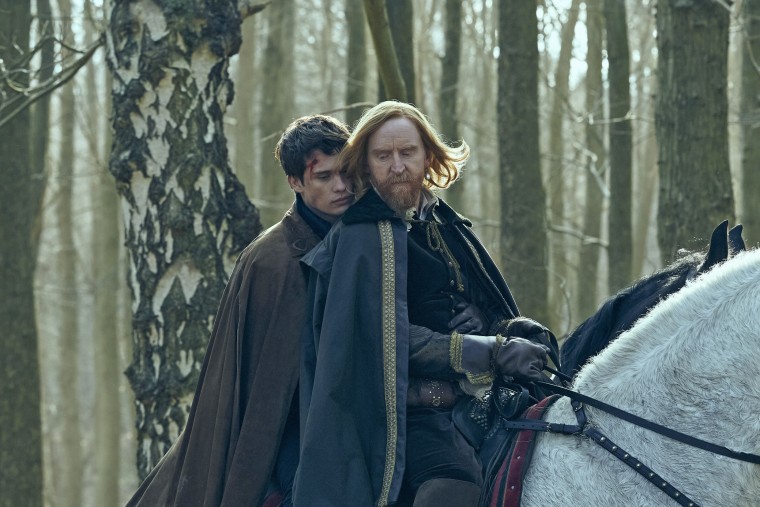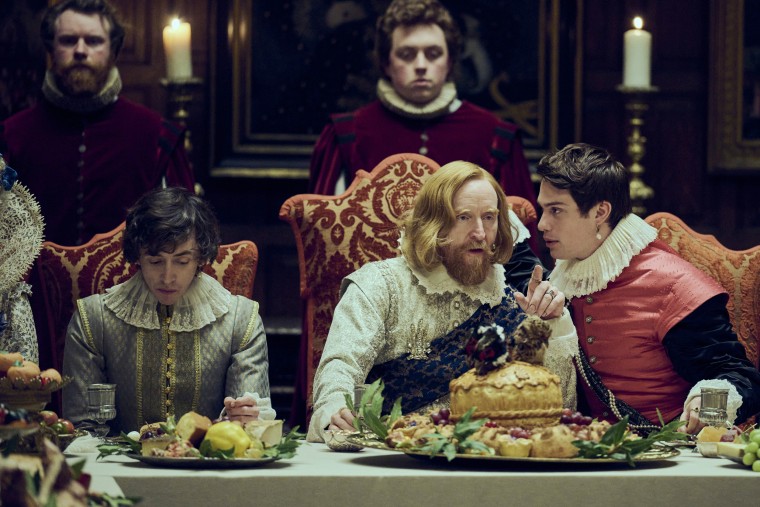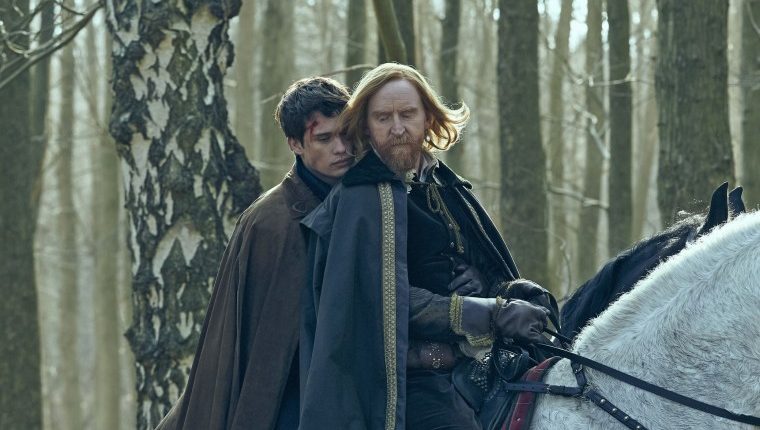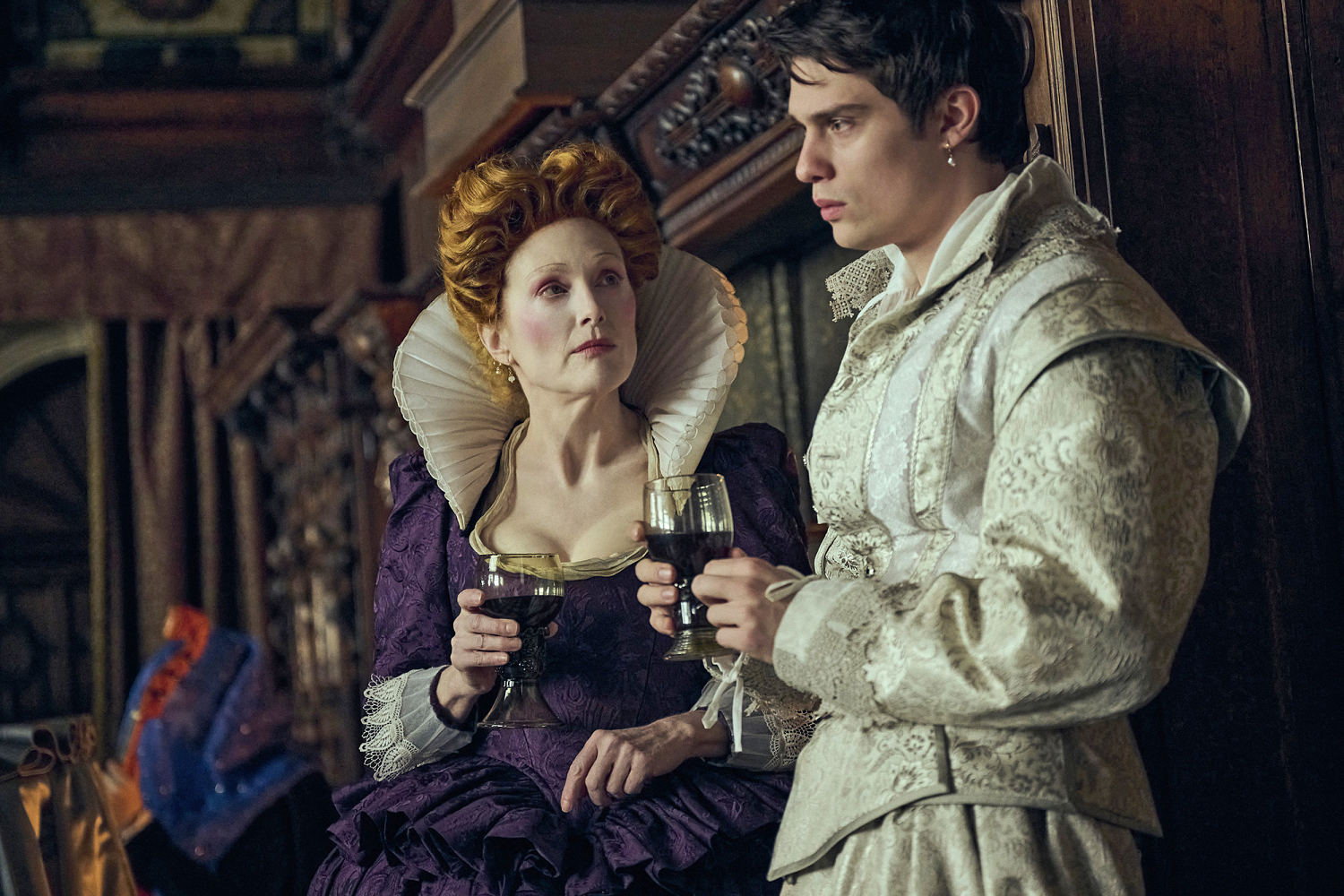It’s not every day that a 400-year-old love affair takes the internet by storm. But social media was abuzz with questions about King James I and his dashing companion, George Villiers, when Starz announced the new series “Mary & George,” which features Tony Curran and Nicolas Galitzine as the 17th century monarch and the man he elevated to the top of Jacobean society.
Like the sex-fueled, late-2000s series “The Tudors” before it, the new seven-part period drama from British playwright D.C Moore is heavy on court intrigue, murderous plots and erotic love scenes. Though, even its more salacious elements are inspired by historical accounts, largely pulled from Benjamin Woolley’s 2017 book, “The King’s Assassin,” which details the real-life relations between James I, George and his mother, Mary Villiers (played by Julianne Moore, who is also a co-producer of the new series).
“You couldn’t believe the goings-on of this group of people. Life is truly stranger than fiction sometimes,” Galitzine, who’s been on a meteoric rise since starring in 2023’s “Red, White & Royal Blue,” told NBC News in an interview with Curran ahead of the series’ U.S. premiere on Friday.

Both Galitzine and his co-star were first introduced to the story of the Villiers duo when they received the script from D.C. Moore’s (no relation to Julianne). Upon diving into Woolley’s book and some of the correspondence between James I and George, the actors said, they both became fascinated by the story of a king in need of companionship and the man who filled his cup.
“I knew a lot about King James (the son of Mary, Queen of Scots) being from Scotland, but there were elements to his character and his monarchy that I didn’t know about, and I didn’t really know about the relationship between the Duke and Duchess of Buckingham,” Curran said, referring to the titles the king eventually bestowed on George and Mary.
“Especially with regards to King James, what I found compelling and quite profound was his loneliness,” he added, mentioning a conversation with Woolley in which the writer described the monarch as “nourished in fear.” “Having his father assassinated, his mother executed — a lot of those traumatic elements of his past as a child definitely infiltrate him in his future. There’s the old adage, ‘Heavy sleeps the head that wears the crown,’ as it were, and I think, with James, it was a big part of that.”
When the series begins, a recently widowed Mary already has a plan in the works to use her second-born son’s charms and her own cunning to raise the family up through the ranks of English society. Procuring the funds for the trip via a new marriage, Mary sends George off to France to learn the ways of the world under the tutelage of a culturally and sexually sophisticated mentor. The once-naive teenager returns as a swaggering young man ready to be introduced to court and, Mary hopes, catch the eye of King James I.
But getting the king’s attention proves to be no simple task, with a throng of male suitors literally lining up to overthrow his current favorite, the Earl of Somerset. In addition to violent rivals, the mother-and-son duo have to overcome James I’s suspicious nature, scheming royal advisers and their own family secrets to win the monarch’s favor. But all their maneuvering doesn’t come without a cost, as each step up the court ladder threatens to end in a harder and potentially fatal fall.
“There’s frivolity, there’s fun, there’s a lascivious nature. But in a very short period of time, in seven episodes, it gets very dark, very quickly. Power corrupts, but absolute power corrupts absolutely. And certainly with this guy, it was the case,” Curran said, playfully gesturing to his younger co-star.

Inspired by events that defined the end of James I’s reign and the beginning of his son’s, Charles I, “Mary & George” does take a dark turn in the later episodes, as the Villiers’ power-grabbing and the monarch’s weakness for his lover begin to have consequences at court and beyond. But the series never quite loses the bawdy energy that defines it from the offset and is inspired by the art, irreverent humor and colorful language of the Jacobean era.
“If you look at the drama of the age, there are big questions of power and politics. But also, every Shakespearean play had a comedian in it who would come on and do a sort of bit. The high and low always existed together,” D.C. Moore, whose TV-writing credits include “Killing Eve,” told NBC News.
Giving examples of tavern-goers singing about George’s role at court and the monarch’s own irreverent style of banter, the writer added, “The Duke of Buckingham was known colloquially in the taverns at the time as the ‘Duke of F—ing-ham.’ King James called his female coterie on his hunts his — you know. So if we had a sort of repressed, ‘Brief Encounter’ style, or a softer period drama, I don’t think it would have been honest about who these characters are.”
Though the playwright said his aim was to capture the feel and language of early 17th century England, he and the series’ stars are quick to point out that “Mary & George” is not a strictly faithful account of the time. Moore noted that he used a contemporary lens to interpret how exactly the Villiers accomplished their swift rise, taking certain liberties with the plot and character portrayals to enhance the series’ entertainment and dramatic richness.
“I would say most every episode is stitched around 10 to 20 real things that happened, but occasionally, you have to stitch all [the characters] into a story that they weren’t necessarily involved in,” he said, pointing to how Mary is portrayed as having a direct hand in plots that cleared the way for George’s path to the king’s bedroom.
While he may have made some leaps regarding Mary’s social-climbing schemes, the dramatist insists that his depiction of the relationship between James I and George is true to the historical record — a point that may surprise a fair amount of viewers when they’re watching the characters’ frequent erotic encounters.
“It wasn’t a secret at the time what was happening between them. It’s tricky because people didn’t want to write about the king, because they might get their heads cut off, but generally, I think it’s hard to look at this period and not see this is a thing that everyone knew,” he said, pointing to correspondence between the men in which they discuss a secret tunnel between their chambers, as well as accounts from ambassadors who visited James I’s court.
“They didn’t have a contemporary mindset, but they didn’t have a Victorian mindset,” he said of the citizens of Jacobean England. “They had a much less clear sense of sexual identities and, I think, probably less reticence about men sleeping together than you would imagine. So we have to be really careful about projecting back a morality that wasn’t there.”
Related links:
While D.C. Moore may have looked to scholarship, including Thomas B. Young’s “King James and the History of Homosexuality,” to inspire his portrayal of the men’s love affair, bringing that dynamic to life on screen was perhaps a less bookish affair.
“The way I approached it was: It’s not a story about a queer relationship; it’s more about, as a human being, what were my intentions? And from the documentation and the correspondence that I read, there was a real deep feeling of love and tenderness for this man, and I think it was reciprocated,” Curran said. “Obviously, there was sensuality in there, as well, but, ultimately, I think it was about loving someone.”
Like Curran — a prolific British TV and film actor, whose breakout role was playing a gay plumber named Lenny in the BBC series “This Life” — Galitzine kicked off his career portraying a trailblazing queer character. But the sheer amount of same-sex onscreen relations in “Mary & George,” which range from intimate embraces to furniture-breaking acrobatics and full-blown orgies, was something new for both him and his co-star. So rather than pulling from his own experience, the up-and-coming leading man channeled something deeper to sell their hot-and-heavy relationship.
“Tony and I are just very naturally aligned as people. We just love working with each other, and I think we both loved the characters that we were playing,” Galitzine said. “And we cared for portraying their relationship on screen in a really authentic, truthful way.”
For more from NBC Out, sign up for our weekly newsletter.
Source: | This article originally belongs to Nbcnews.com










